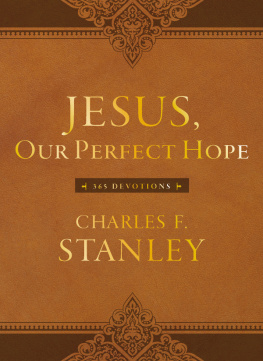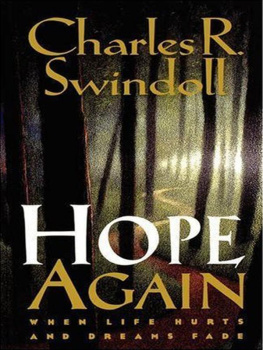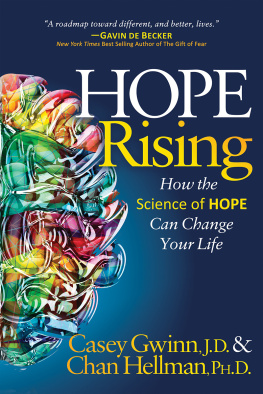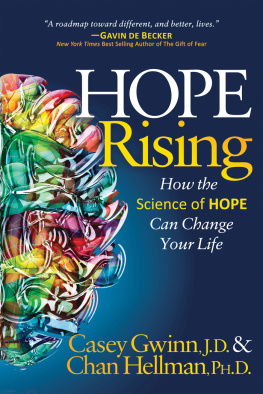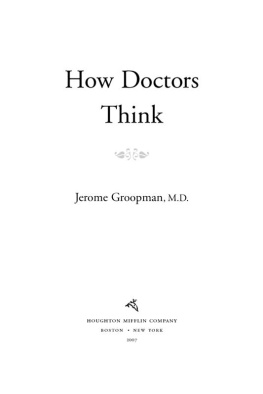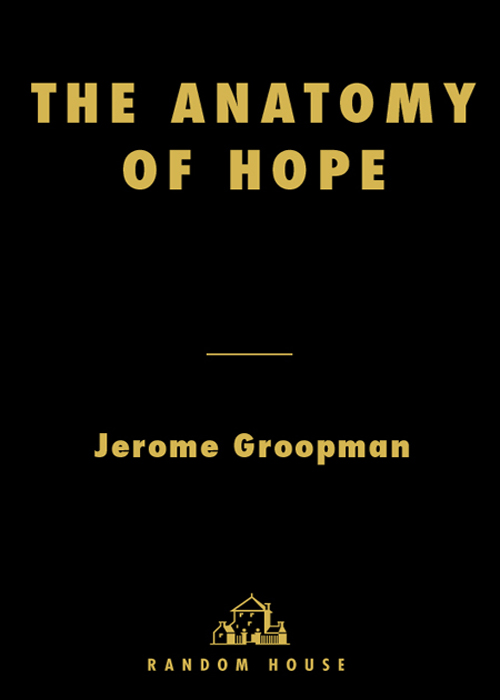Jerome Groopman, M.D.
Pandora, the first mortal woman, received from Zeus a box that she was forbidden to open. The box contained all human blessings and all human curses. Temptation overcame restraint, and Pandora opened it. In a moment, all the curses were released into the world, and all the blessings escaped and were lostexcept one: hope. Without hope, mortals could not endure.
Introduction
The Anatomy of Hope
W hy do some people find hope despite facing severe illness, while others do not? And can hope actually change the course of a malady, helping patients to prevail?
I looked for the answers in the lives of several extraordinary patients I cared for over the past thirty years. They led me on a journey of discovery from a point where hope was absent to a place where it could not be lost. Along the way, I learned the difference between true hope and false hope, and describe times when I foolishly thought the latter was justified. There were also instances when patients asserted their right to hope and I wrongly believed they had no reason to do so. Because they held on to hope even when I could not, they survived. And one woman of deep faith showed me that even when there is no longer hope for the body, there is always hope for the soul. Each person helped me see another dimension of the anatomy of hope.
Hope is one of our central emotions, but we are often at a loss when asked to define it. Many of us confuse hope with optimism, a prevailing attitude that things turn out for the best. But hope differs from optimism. Hope does not arise from being told to think positively, or from hearing an overly rosy forecast. Hope, unlike optimism, is rooted in unalloyed reality. Although there is no uniform definition of hope, I found one that seemed to capture what my patients had taught me. Hope is the elevating feeling we experience when we seein the minds eyea path to a better future. Hope acknowledges the significant obstacles and deep pitfalls along that path. True hope has no room for delusion.
Clear-eyed, hope gives us the courage to confront our circumstances and the capacity to surmount them. For all my patients, hope, true hope, has proved as important as any medication I might prescribe or any procedure I might perform. Only well into my career did I come to realize this. During my training in medical school classrooms and on hospital teaching rounds, we saw patients as fascinating puzzles. Making a diagnosis and finding the optimal therapy were essentially detective work. We mined the stories of patients lives for clues. Family background, experiences at the workplace, travel, personal habits, and relationships all gave hints to solving the clinical mystery. The family history provided information about inherited genes and how they predisposed people to one disorder or another; the workplace suggested potential exposure to carcinogenic chemicals or poisonous metals; travel could bring contact with arcane pathogens that populate far regions of the world; habits like smoking and drinking could promote pathology; and relationships helped uncover sexually transmitted diseases like syphilis, HIV, and gonorrhea.
Solving a complex case and identifying the best treatment is indeed an exhilarating intellectual exercise. But the background and stories of patients lives give doctors the opportunity to probe another mystery: How do hope, and despair, factor into the equation of healing?
For nearly three decades I have practiced hematology and oncology, caring for patients with cancer, blood diseases, HIV, and hepatitis C. I have also labored in my laboratory, studying the genes and proteins that these disorders derange. During much of that time, at the bedside and at the laboratory bench, I failed to consider the impact of hope on my patients illness. Yes, I gave the customary nod to it, but then I would focus squarely on interpreting their laboratory reports, reading their CAT scans, and studying their biopsiesall essential to diagnosis and treatment, but incomplete. What was missing had to be learned from experience. I had to be testednot on paper but by overcoming adversity, both as physician and as patient.
A vast popular literature exists contending that positive emotions affect the body in health and disease. Much of it is vague, unsubstantiated, merely wishful thinking. These books depict hope as a magic wand in a fairy tale that will, by itself, miraculously restore a patient. As a rational scientist, trained to decode the sequence of DNA and decipher the function of proteins, I fled the fairy-tale claims of hope. In effect, I slammed the door on hope and closed off my mind to seriously considering it as a catalyst in the crucible of cure.
Personal experience opened my mind. For some nineteen years after failed spine surgery, I lived in a labyrinth of relapsing pain and debility. Then, through a series of chance circumstances, I found an exit. I felt I had been given back my life. I recognized that only hope could have made my recovery possible. Rekindled hope gave me the courage to embark on an arduous and contrarian treatment program, and the resilience to endure it. Without hope, I would have been locked forever in that prison of pain. But I also sensed that hope had done more than push me to take a chance and not give up. It seemed to exert potent and palpable effects not only on my psychology but on my physiology.
As a scientist, I distrusted my own experience, and set out on a personal journey to discover whether the energizing feeling of hope can in fact contribute to recovery. I found that there is an authentic biology of hope. But how far does it reach? And what are its limits? Researchers are learning that a change in mind-set has the power to alter neurochemistry. Belief and expectationthe key elements of hopecan block pain by releasing the brains endorphins and enkephalins, mimicking the effects of morphine. In some cases, hope can also have important effects on fundamental physiological processes like respiration, circulation, and motor function. During the course of an illness, then, hope can be imagined as a domino effect, a chain reaction in which each link makes improvement more likely. It changes us profoundly in spirit and in body.
Every day I look for hope, for my patients, for my loved ones, and for myself. It is an ongoing search. Here I tell what I have found.
A Note from the Author
While all of the incidents in this book are true, the names and personal characteristics of the individuals involved have been changed in order to protect their privacy. Any resulting resemblance to other persons, living or dead, is entirely coincidental and unintentional.
CHAPTER 1
Unprepared
I n July 1975, I entered my fourth and final year of medical school at Columbia University in New York City. I had completed all my required courses except surgery and was eager to engage in its drama.
Surgeons acted boldly and decisively. They achieved cures, opening an intestinal blockage, repairing a torn artery, draining a deep abscess, and made the patient whole again. Their art required extraordinary precision and self-control, a discipline of body and mind that was most evident in the operating room, because even minor mistakestoo much pressure on a scalpel, too little tension on a suture, too deep probing of a tissuecould spell disaster. In the hospital, surgeons were viewed as the emperors of the clinical staff, their every command obeyed. We students were their foot soldiers. I was intoxicated with the idea of being part of their world.


